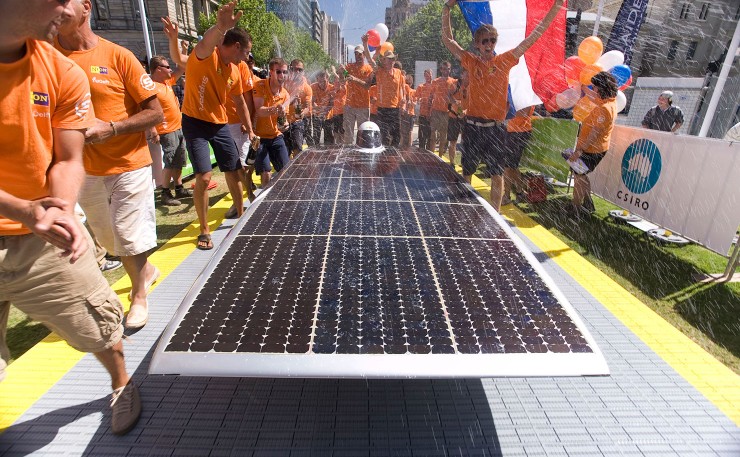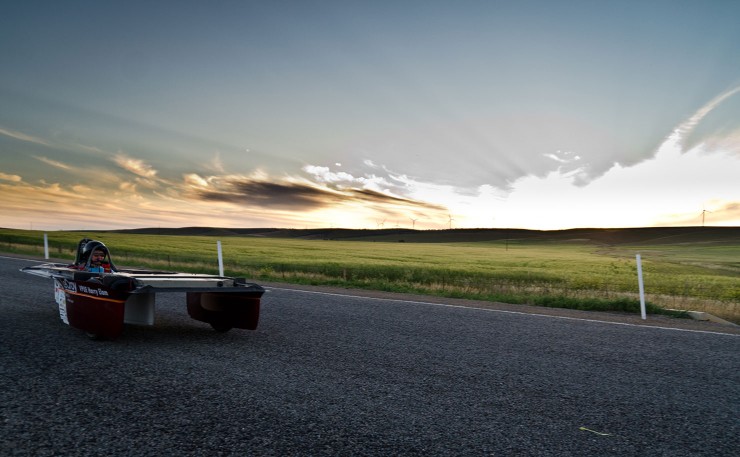The World Solar Challenge ambled across Central Australia last week. Geoff Russell definitely wasn’t holding his breath waiting for it to finish.
Last Friday, I wandered around Victoria Square in Adelaide watching the people watching the solar powered cars of the World Solar Challenge. Some were still arriving from Darwin; escorted by real cars with flashing lights before and after.
At 38 years of age, this event is much older than many of the crew crammed into anorexic cockpits or following in support vehicles. It began in 1987, about two years before Professor Martin Green of UNSW predicted that solar would replace coal in “10 to 15 years”.
I couldn’t help wondering how many more decades it can call itself a “Challenge” without facing up to the normal rigors faced by real vehicles.
Real motor vehicles have to run all year round, under clouds, at dusk even by the light of a new moon. Even bicycles in most parts of the world confront and master such challenges.
The closest thing this middle aged race has to real cars is the newish cruiser category, which it says is designed to “encourage solar cars designed for practicality and acceptance in a given market segment”.
The winner of this class in 2015 is the OWL from Kogakuin University. It’s average speed on the last day running into Adelaide was 42 kilometers an hour… about the same as professional cyclists do for the 260 kilometers of the one day Paris-Rubais bicycle race.
On day 4 the average speed of OWL was just 33 kilometers per hour; rather less than professional cyclists do in any race, even in any of the European Alps. The regulations don’t specify just what market segment will be impressed by such performance.
If they want to call this race a Challenge, then why not run it during winter? Or let the cars operate at night? And if they really want a challenge then why not run it in Holland so that at least the Dutch can enjoy victory in front of their home crowd!

Perhaps they could run it simultaneously with the Rotterdam Marathon. Of course, the cars would probably have to start after the runners to avoid the risk of being overtaken should the Dutch skies suddenly cloud cover.
Being an avid fan of cycling grand tours, I’m fine with a solar powered car race. But I confess to being irritated by the pretence that this race has anything to do with clean energy and environmental concern.
Recently the solar advocacy industry got all excited about an attempt to fly around the world in a solar plane. But, like the cars, it’s also little more than an incredibly expensive toy. The Solar Impulse 2 weighs 2.3 tonnes and carries one person and 633 kilograms of lithium polymer batteries. It’s currently stuck on its round the world quest in Hawaii because the batteries are buggered.
We should perhaps remember at this stage that it was a little more than 10 years after the first Wright Brothers flight that real planes were engaged in World War I dog fights over Europe.
Some technologies work and some just limp along perpetually as an engineering embarrasment for decade after decade of dismal failure. The embarrasment isn’t that the World Solar Challenge has been failing to yield practical solar powered transport for 38 years, but that this has been predictable for at least 100 years.
Even if you could capture 100 percent of the available sunshine, you’d still not have enough to replicate the kinds of transport that we need.
We need buses, we need trains and we need to shift millions of tonnes of food harvests annually.
We need clean transportation and we have a pretty good idea of what will work; bicycles are great for many things, electricity for slightly larger stuff and synthetic fuels or perhaps hydrogen for the heavy lifting.
There isn’t much of a niche for under-powered toys which crawl under clouds and stop at dusk. To solve our clean transport imperative requires buckets of extra energy to displace fossil fuels, and we know how to do it.
By the time the “Solar Challenge” began, the French had almost finished decarbonising their entire electricity system with nuclear power.
That took about 15 years.
In 1960 the first nuclear powered circumnavigation of the planet took place. Did they do it in summer with a petrol powered support crew? Hell no; they did it underwater carrying 170 people.
We know what works and what doesn’t, but the fascination with stuff which doesn’t is as inexplicable as the rise and rise of One Direction or Star Wars.
So why do people persist with a technology that’s been failing for decades?
I don’t mind people playing solar race games but we have a serious climate problem to deal with, we don’t have much time and Martin Green and mates have cost us dearly.
Donate To New Matilda
New Matilda is a small, independent media outlet. We survive through reader contributions, and never losing a lawsuit. If you got something from this article, giving something back helps us to continue speaking truth to power. Every little bit counts.




